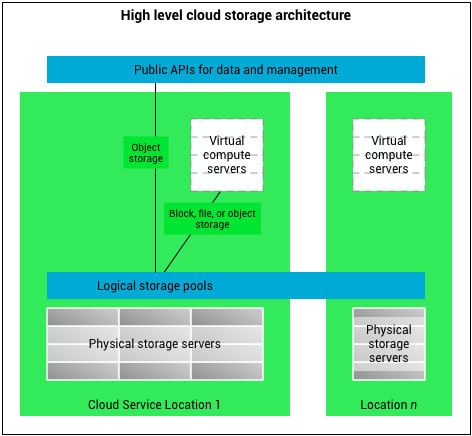 | ||
Cloud storage is a model of data storage in which the digital data is stored in logical pools, the physical storage spans multiple servers (and often locations), and the physical environment is typically owned and managed by a hosting company. These cloud storage providers are responsible for keeping the data available and accessible, and the physical environment protected and running. People and organizations buy or lease storage capacity from the providers to store user, organization, or application data.
Contents
- History
- Architecture
- Advantages
- Attack surface area
- Supplier stability
- Accessibility
- Other concerns
- References
Cloud storage services may be accessed through a co-located cloud computer service, a web service application programming interface (API) or by applications that utilize the API, such as cloud desktop storage, a cloud storage gateway or Web-based content management systems.
History
Cloud computing is believed to have been invented by Joseph Carl Robnett Licklider in the 1960s with his work on ARPANET to connect people and data from anywhere at any time.
In 1983, CompuServe offered its consumer users a small amount of disk space that could be used to store any files they chose to upload.
In 1994, AT&T launched PersonaLink Services, an online platform for personal and business communication and entrepreneurship. The storage was one of the first to be all web-based, and referenced in their commercials as, "you can think of our electronic meeting place as the cloud." Amazon Web Services introduced their cloud storage service AWS S3 in 2006, and has gained widespread recognition and adoption as the storage supplier to popular services such as Smugmug, Dropbox, Synaptop and Pinterest. In 2005, Box announced an online file sharing and personal cloud content management service for businesses.
Architecture
Cloud storage is based on highly virtualized infrastructure and is like broader cloud computing in terms of accessible interfaces, near-instant elasticity and scalability, multi-tenancy, and metered resources. Cloud storage services can be utilized from an off-premises service (Amazon S3) or deployed on-premises (ViON Capacity Services).
Cloud storage typically refers to a hosted object storage service, but the term has broadened to include other types of data storage that are now available as a service, like block storage.
Object storage services like Amazon S3 and Microsoft Azure Storage, object storage software like Openstack Swift, object storage systems like EMC Atmos, EMC ECS and Hitachi Content Platform, and distributed storage research projects like OceanStore and VISION Cloud are all examples of storage that can be hosted and deployed with cloud storage characteristics.
Cloud storage is:
Advantages
Attack surface area
Outsourcing data storage increases the attack surface area.
- When data has been distributed it is stored at more locations increasing the risk of unauthorized physical access to the data. For example, in cloud based architecture, data is replicated and moved frequently so the risk of unauthorized data recovery increases dramatically. (e.g. disposal of old equipment, reuse of drives, reallocation of storage space) The manner that data is replicated depends on the service level a customer chooses and on the service provided. that encrypts data prior to uploading it to the cloud.
- The number of people with access to the data who could be compromised (i.e. bribed, or coerced) increases dramatically. A single company might have a small team of administrators, network engineers and technicians, but a cloud storage company will have many customers and thousands of servers and therefore a much larger team of technical staff with physical and electronic access to almost all of the data at the entire facility or perhaps the entire company. Encryption keys that are kept by the service user, as opposed to the service provider limit the access to data by service provider employees. As for sharing the multiple data with multiple users in cloud, a large number of keys has to be distributed to users via secure channels for decryption, also it has to be securely stored and managed by the users in their devices. And storing these keys requires rather expensive secure storage. To overcome that Key-aggregate cryptosystem can be used.
- It increases the number of networks over which the data travels. Instead of just a local area network (LAN) or storage area network (SAN), data stored on a cloud requires a WAN (wide area network) to connect them both.
- By sharing storage and networks with many other users/customers it is possible for other customers to access your data. Sometimes because of erroneous actions, faulty equipment, a bug and sometimes because of criminal intent. This risk applies to all types of storage and not only cloud storage. The risk of having data read during transmission can be mitigated through encryption technology. Encryption in transit protects data as it is being transmitted to and from the cloud service. Encryption at rest protects data that is stored at the service provider. Encrypting data in an on-premises cloud service on-ramp system can provide both kinds of encryption protection.
Supplier stability
Companies are not permanent and the services and products they provide can change. Outsourcing data storage to another company needs careful investigation and nothing is ever certain. Contracts set in stone can be worthless when a company ceases to exist or its circumstances change. Companies can:
- Go bankrupt.
- Expand and change their focus.
- Be purchased by other larger companies.
- Be purchased by a company headquartered in or move to a country that negates compliance with export restrictions and thus necessitates a move.
- Suffer an irrecoverable disaster.
